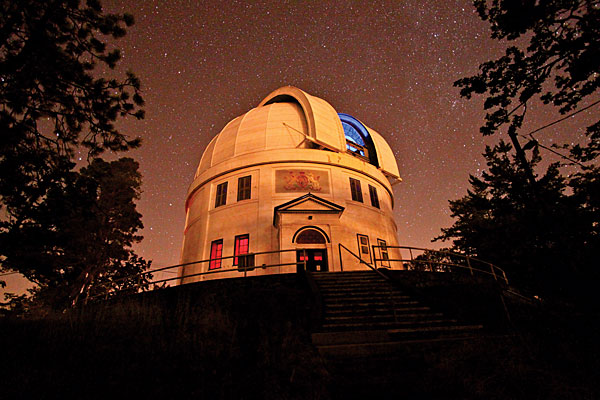Business emphasis at research council has Canada’s scientists concerned
DOI: 10.1063/PT.3.2041
Canada is restructuring its National Research Council, which does in-house scientific research, funds external projects, and provides services to industry, to focus mainly on industry. The move is motivated by a wide recognition that Canada lags other countries in innovation, according to NRC president John McDougall. “We want to fill the gaps between discovery and things in the marketplace.” But researchers worry about the repercussions of what they see as yet another in a series of slaps the government has dealt science (see Physics Today, July 2012, page 20
Unveiled on 7 May, the new structure of the NRC has been in the making since the release nearly two years ago of the government-commissioned report Innovation Canada: A Call to Action, which said Canada should identify strategic areas, streamline its interactions with companies, and focus more on commercialization. The NRC response includes a reorganization from 21 independent institutes into 12 R&D portfolios falling into the three categories of engineering, emerging technologies, and life sciences. In the process, the NRC has shed at least two institutes: A medical diagnostics center in Manitoba was closed, and in April the Canadian Neutron Beam Centre was transferred to Atomic Energy of Canada. “This refocused NRC, with a business-led innovation mission, is pivotal to the future of Canadian jobs, economic growth, and our long-term prosperity,” said Gary Goodyear, minister of state for science and technology.
Tools for industry
A key feature of the refocused NRC will be large industrial R&D projects. The first one, announced on 10 May, will explore using algae to convert carbon dioxide emissions from Alberta’s oil sands into such things as biofuel and animal feed. Some 40 projects are to be launched over the next year; each will feature a partnership with industry and receive annual government funding ranging from a few million dollars to nearly Can$20 million (roughly $19.5 million). “These projects are longer term, higher risk,” says McDougall. “We are trying to ensure that industry can stay competitive by providing the technologies that industry will need.”
About Can$350 million of the council’s Can$900 million budget will go to those large projects and technical services combined. With technical services, the NRC sells access to equipment that is too specialized or expensive for companies to own. Examples include wind tunnels to test the aerodynamics of aircraft and bridges, and a climate chamber for testing vehicle performance in conditions from desert to arctic.
The NRC is also ramping up its industrial research assistance program, through which it provides financial and advisory support to small and medium enterprises. Funding for that doubled to Can$220 million this year. And, comparable to budgets of recent years, about Can$150 million will go to basic research and to maintain the national scientific infrastructure already under the council’s purview, including Triumf, the particle and nuclear physics lab in Vancouver; astronomical facilities in Victoria and Penticton, British Columbia; and a metrology facility in Ottawa, Ontario.
Risks and rewards
Although no one disputes the benefits of boosting innovation, many in the research community worry that in focusing on short-term, industry-driven goals, the NRC risks losing its capacity in basic research. Says Gabor Kunstatter, president of the Canadian Association of Physicists, “We like to point to canola oil. It’s a triumph of Canadian research and was developed over decades. If the NRC had had a short-term focus, there’s a good chance it would never have happened.” The canola industry generates Can$15 billion annually for Canada.
The community is still smarting over restrictions on talking to the press that the government put on its employees about two years ago, and it has also watched the number of peer-reviewed publications coming out of the NRC decline. Now physicists and astronomers are asking how participation in the Thirty Meter Telescope and the Square Kilometer Array might be affected, given that the NRC’s Herzberg Institute of Astrophysics coordinates Canada’s involvement in those and other international projects. The restructuring at NRC, says Kunstatter, “is a net loss for basic science. It’s a fairly major blow.”
The NRC has traditionally maintained measurement standards and helped industry. But as the council’s focus on industry sharpens, says physicist Paul Corkum, “you have to worry about isolation from other aspects of science in Canada and internationally.” He points to the NRC–University of Ottawa Joint Attosecond Laboratory, which he heads, as a “superb” approach to keep the NRC connected to the broader science community.
Goodyear compares the refocused NRC to Germany’s Fraunhofer organization, a network of applications-oriented institutes. “In some sense that’s fine,” says Simon Fraser University biophysicist John Bechhoefer. “But what they don’t say is that Germany still has and funds the Max Planck Institutes. We don’t have anything like the Max Planck.”

Many scientists are asking if the future is safe for basic science—such as this telescope at the Dominion National Observatory in Victoria, British Columbia—at the National Research Council of Canada.
NATIONAL RESEARCH COUNCIL OF CANADA

More about the Authors
Toni Feder. tfeder@aip.org
